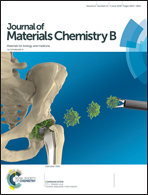Fully edible biofuel cells†
Abstract
The first example of a fully edible biofuel cell (BFC), based solely on highly biocompatible food materials without any additional external mediators, is described. The new BFC energy-harvesting approach relies on a variety of edible plant/mushroom extract/vegetable oil/charcoal paste biocatalytic electrodes and represents an attractive route for energy harvesting towards ingestible biomedical devices. The edible BFC anode and cathode paste materials consist of biocatalytic rich mushroom, apple, plum and banana plant tissues, along with dietary activated charcoal and water-immiscible olive oil, corn oil, and sesame oil for creating the paste matrix. The ethanol/O2 BFC relies on a bioanode, based on ethanol oxidation induced by the intrinsic biocatalytic activity of its mushroom component, along with a biocathode based on oxygen-reducing apple extract containing polyphenol-oxidase and phenolic compounds. The integrated natural catalytic system and selective biocatalytic activity of the natural extracts offer successful operation of BFCs without any extra mediators or membrane separating the anode and the cathode. The mushroom/apple/olive oil-based BFC displays a favorable power density of 282 μW cm−2 with an open circuit voltage (OCV) of 0.24 V. The power and OCV signals are linearly proportional to ethanol levels and indicate promise for self-powered alcohol sensing. The food-based BFCs were reproducible and able to maintain a power performance of over 80% of their initial output for four hours. These edible energy-harvesting BFCs hold great promise for the next-generation of ingestible devices and smart self-powered biosensors for monitoring health and the digestive system.



 Please wait while we load your content...
Please wait while we load your content...